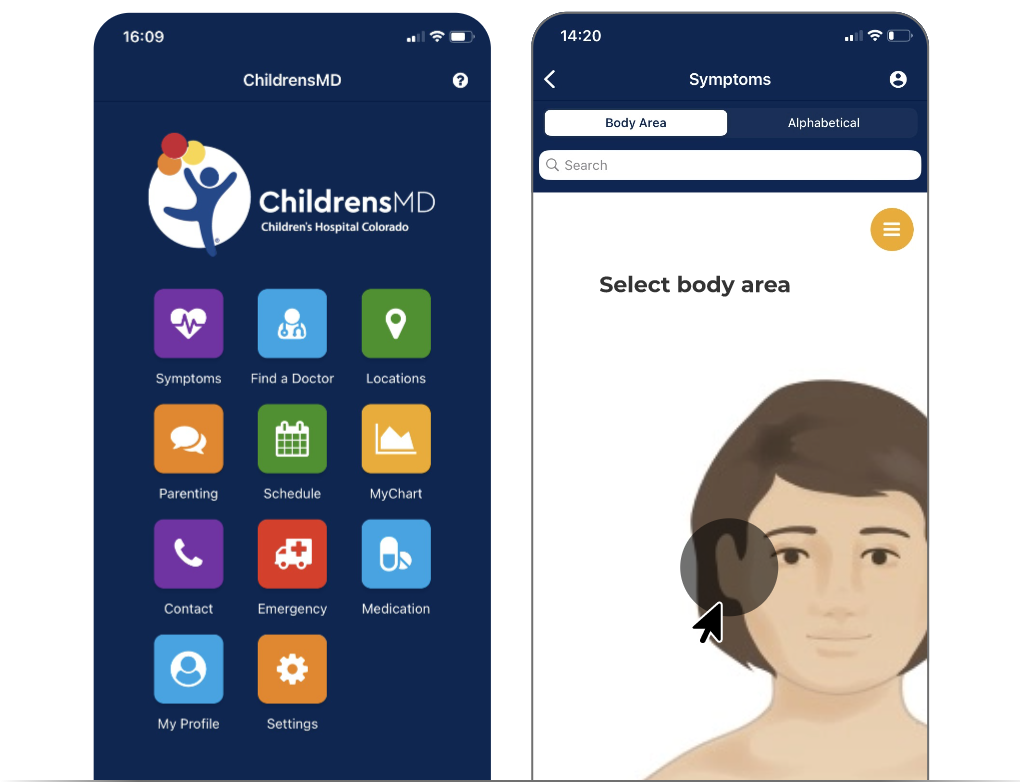- Doctors & Departments
-
Conditions & Advice
- Overview
- Conditions and Symptoms
- Symptom Checker
- Parent Resources
- The Connection Journey
- Calm A Crying Baby
- Sports Articles
- Dosage Tables
- Baby Guide
-
Your Visit
- Overview
- Prepare for Your Visit
- Your Overnight Stay
- Send a Cheer Card
- Family and Patient Resources
- Patient Cost Estimate
- Insurance and Financial Resources
- Online Bill Pay
- Medical Records
- Policies and Procedures
- We Ask Because We Care
Click to find the locations nearest youFind locations by region
See all locations -
Community
- Overview
- Addressing the Youth Mental Health Crisis
- Calendar of Events
- Child Health Advocacy
- Community Health
- Community Partners
- Corporate Relations
- Global Health
- Patient Advocacy
- Patient Stories
- Pediatric Affiliations
- Support Children’s Colorado
- Specialty Outreach Clinics
Your Support Matters
Upcoming Events
Child Life 101
Wednesday, June 12, 2024Join us to learn about the work of a child life specialist, including...
-
Research & Innovation
- Overview
- Pediatric Clinical Trials
- Q: Pediatric Health Advances
- Discoveries and Milestones
- Training and Internships
- Academic Affiliation
- Investigator Resources
- Funding Opportunities
- Center For Innovation
- Support Our Research
- Research Areas

It starts with a Q:
For the latest cutting-edge research, innovative collaborations and remarkable discoveries in child health, read stories from across all our areas of study in Q: Advances and Answers in Pediatric Health.


Fire Ant Sting
Get Care Now
From emergency to urgent care to 24/7 pediatric advice, we’re here to help in the heat of moment.
- Stung by a fire ant
- Fire ant stings are more common in the Southern U.S.
Local Skin Reactions to the Sting
- The main symptoms are pain, burning, swelling and redness at the sting site.
- Pain and burning at the site usually lasts 10 minutes. The pain is far less than that of a bee sting.
- Itching follows the pain and can last for weeks.
- Hive-like bump occurs at sting site within 30 minutes (100%). This looks like a red spot with raised white center.
- Pimples with yellow fluid (pustules) occur at the sting site within 24 hours (96%). These pimples are almost diagnostic for fire ant stings. They are very itchy. They usually open on their own by 3 days. Then, they dry over. Sometimes, they can last for up to a week.
- Normal Swelling from venom can increase for 24 hours after the sting. Stings of the upper face can cause severe swelling around the eye. This is harmless.
- Severe Swelling. Sometimes, fire ant bites can cause severe swelling. Hand or foot bites can cause swelling that crosses the wrist (or ankle). The degree of swelling can interfere with function and need steroids. These do not carry an increased risk of allergic reaction with future stings.
- Redness. Stings can become red. This is normal. That doesn't mean they are infected. Infections rarely occur in stings.
Anaphylactic Reaction to the Sting
- A severe life-threatening allergic reaction is called anaphylaxis.
- The main symptoms are hives with trouble breathing and swallowing. It starts within 2 hours of the sting.
- This severe reaction to fire ant stings happens in 1 to 2% of children.
- Hives. After fire ant stings, some children just develop hives all over or face swelling. Hives or face swelling alone may be able to be treated at home. But, at times, these symptoms can also lead to anaphylaxis. Be sure to call your doctor now to help decide.
Cause of Fire Ant Sting Reactions
- The ant's stinger injects venom into the skin.
- The venom is what causes all the symptoms.
- A fire ant attaches to the skin with its jaws and swivels its body. It stings multiple times with its back stinger.
- One fire ant can leave a semi-circular pattern of more than one sting.
General Information About Fire Ants
- In infested areas, fire ants cause many more stings than bees or yellow jackets.
- Over 50% of people living in these areas are stung each year.
- Fire ants are found throughout the Southern U.S., from Florida to Texas. They have also appeared in California, New Mexico and Arizona.
- Colonies of fire ants live in small mounds of dirt, usually 6 inches tall.
- When the mound is disturbed, hundreds of fire ants stream out and attack.
- The fire ant causes a "burning" feeling at the site of the stings. This is how it got its name.
Prevention of Fire Ant Stings
- The only way to prevent fire ant stings is to avoid their colonies.
- Teach your children to know their colonies (mounds) and to keep their distance.
- Insect repellents (including those that have DEET) don't help to prevent fire ant stings.
- Wear socks. Fire ants cannot bite through socks.
Call 911 Now
- Past severe allergic reaction to fire ant stings (not just hives) and stung less than 2 hours ago
- Wheezing or trouble breathing
- Hoarseness, cough or tightness in the throat or chest
- Trouble swallowing or drooling
- Speech is slurred
- Acts or talks confused
- Passed out (fainted) or too weak to stand
- You think your child has a life-threatening emergency
Go to ER Now
- Hives or swelling all over the body
Call Doctor or Seek Care Now
- Sting inside the mouth
- Sting on the eye
- Stomach pain or vomiting
- Age less than 1 year with 20 or more stings. Newborn if more than 5.
- More than 5 stings for 10 pounds (5 kg) of weight. In teens, more than 50 stings.
- Fever and sting looks infected (spreading redness)
- Your child looks or acts very sick
- You think your child needs to be seen, and the problem is urgent
Contact Doctor Within 24 Hours
- Painful spreading redness started more than 24 hours after the bite. Note: any redness starting in the first 24 hours is a reaction to the bite.
- More than 48 hours since the sting and redness getting larger
- Swelling is huge (4 inches or 10 cm). It spreads across a joint such as the wrist.
- You think your child needs to be seen, but the problem is not urgent
Contact Doctor During Office Hours
- Scab that looks infected (drains pus or gets bigger) not better with antibiotic ointment
- Severe itching not better after 24 hours of using steroid cream
- You have other questions or concerns
Self Care at Home
- Normal reaction to a fire ant sting
Care Advice for Fire Ant Stings
What You Should Know About Fire Ant Stings:
- Pain from a fire ant sting is less severe than with a bee sting. Most often, it's gone in 10 minutes.
- Fire ant stings form a pimple and become red. This is normal. That doesn't mean they are infected.
- Here is some care advice that should help.
Pain Medicine:
- To help with the pain, give an acetaminophen product (such as Tylenol).
- Another choice is an ibuprofen product (such as Advil).
- Use as needed.
Steroid Cream for Itching:
- For relief of itching, use 1% hydrocortisone cream (such as Cortaid). Use 3 times per day. No prescription is needed.
Allergy Medicine for Itching:
- If itching becomes severe, give a dose of Benadryl.
- No prescription is needed. Age limit: 1 and older.
Pustules (Pimples) - Do Not Open:
- By 24 hours, a small blister will form over the sting.
- Do not open them.
- Try not to scratch them.
- If you open the blisters, they often become infected.
- Left alone, they will most likely dry up in 4 days.
Antibiotic Ointment:
- If the pimples break open, use an antibiotic ointment (such as Polysporin.) No prescription is needed.
- Use 3 times per day to prevent skin infections. Keep using it for 1 or 2 days.
What to Expect:
- Severe pain or burning at the site lasts 5 to 10 minutes.
- Itching follows the pain and is the main symptom. It can last a week.
- Swelling: normal swelling from ant venom can increase for 24 hours after the sting.
- The redness can last 3 days and the swelling 7 days.
Call Your Doctor If:
- Redness lasts over 3 days
- Swelling becomes huge or spreads past the wrist or ankle
- Sting begins to look infected (redness gets larger after 48 hours)
- You think your child needs to be seen
- Your child becomes worse
Copyright 2000-2024. Schmitt Pediatric Guidelines LLC.
Disclaimer: this health information is for educational purposes only. You, the reader, assume full responsibility for how you choose to use it.

Get to know our pediatric experts.

Lori Lewis, CPNP-AC/PC
Certified Pediatric Nurse Practitioner, Certified Pediatric Nurse Practitioner
Patient ratings and reviews are not available Why?

Nikita Habermehl, DO
Emergency Medicine - Pediatric, Pediatrics
Patient ratings and reviews are not available Why?





 720-777-0123
720-777-0123





